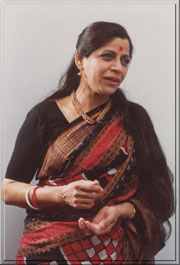 |
|
|
|
W o r k s h o p f o r c h i l d r e n To learn music is not simply to learn a raag or a taal. The basic elements of music are: 1. Rhythm 2. Notes/Tone 3. Words/Poem They are very deeply rooted in some of the most taken for granted things, is life. Rhythm, for example, is present in organic bodily activities, like heartbeats, the equidistant walk, the equidistant divisions of 24 hours of a day. We often teach this to infants, when we teach them to clap. As infants acquire control over their muscles, they are able to give claps with equal distance. That?is rhythm. The internal bodily rhythm is maintained automatically. But the external rhythm has to be taught. That can be done through a game of claps? claps that are equidistant. Once the children master the equidistant rhythm, the concept of the add beat can be dealt with. That is the second game of claps even and odd. Then comes the? concept of sound: Low/high Soft/harsh Pitch : low/middle high. The variation in sound conveys meaning E.g. boredom is conveyed in a low sound, excitement is expressed in a higher pitch. The speed varies along with emotion. Conduct a game of dialog between two groups Through the nature of claps, An interesting dialogue is possible between two individuals, not groups. The next element is a word with consonants and vowels. Some voice exercises can be taught to improve the production of vowels. (E.g. Omkar), as well as consonants ( EG. Whispering , clenching of teeth ) teeth). Seven notes suggest games of seven numbers. Combinations of notes, which are called 'Alankar', can be converted into numbers. This can be conducted as a game for two groups. One group can give numbers and ask or the other to recognize the notes and vice versa. Combinations of notes form certain shapes, which can be drawn on a black board. That makes a game. It can be conducted in two groups. Then teach a simple 'Sargam'. Try to make a drawing of the Sargam. Each one should make it in one's own notebook and the teacher should draw it on the blackboard. We use certain pitch while we speak, use certain notes, tentatively, to express ourselves better. Take some illustrations and find out which pitch and which notes will be suitable for the sentences, that one takes for illustration. How does one speak to infants? Take illustrations. The language of gestures is equally communicative. Think of: 1. Language of the dumb and deaf 2. Language of dance. Notes and vowels do communicate a lot. But it is the consonants and words made out of them that define what the vowels and? words suggest. They explore meaning into the flowing notes and vowels, and express emotions, sensations, thoughts and create beautiful artistic patterns. A song with a tune, rhythm and words, is the simplest example? of this. Now let the children make a song themselves, Each one can participate in making it? writing, making the tune. and practicing it. The workshop can conclude with a song of the children. |
|
|
 |
|
FOR MORE INFORMATION CONTACT THE ARTIST AT neelabhagwat@yahoo.com |
